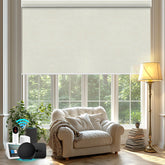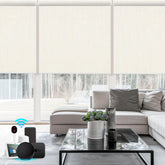Do Light-Filtering Roller Shades Provide Privacy at Night?
When you are picking window treatments for your home, privacy is usually top of mind, especially after the sun goes down. Light-filtering roller shades are a favorite, thanks to their gentle translucence and sleek, minimal design.
They give you a pleasant glow during the day and look tidy from the street. The bigger question, however, is how well they protect your privacy after dark.
Come with us! You will find out what these shades are, how they behave in different lighting, the advantages and drawbacks they bring to the table, and whether they meet your nighttime privacy needs.

What Are Light-Filtering Roller Shades?
Light-filtering roller shades consist of a specially woven fabric that permits daylight to pour in while taming the brightness and softening contrasts. The design is oriented toward letting light filter through rather than sealing the window completely.
Key Features:
- Constructed from either woven or non-woven textiles
- Offered in an extensive palette of colors, patterns, and textures
- Attached to a roller tube for easy and silent motion
- Permit soothing daylight in by day
- Shield interior textiles from fading under the sun
Light-filtering shades fill a room with a gentle, inviting light, making them perfect for areas where you want a cheery feel without the fierce glare of direct sun.
They work beautifully during the day, yet privacy at night requires a different solution.
How Do Light-Filtering Shades Work?
The shades scatter sunlight as it enters, letting gentle brightness fill the space while preventing a clear view from the outside.
The result is soft, glare-free illumination that brightens surfaces without laying bare the room.
The fabric acts like a sheer veil, softening the light yet still permitting some sight. This is advantageous during the day; however, when night falls and the outside becomes darker than the inside, the balance tips.
At night, the fabric that gently softens daytime sun now lets warm light from inside drift outward, and the result is a soft glow that can draw the eye of anyone standing close to the window.
What Happens at Night?
This is the key moment to weigh when choosing light-filtering roller shades.
During the Day:
- Soft daylight pours in.
- Passersby can’t see in.
- Your space feels open yet private.
After Dark:
- Interior lights stand out against the black.
- Fabrics shimmer from within.
- Figures, movements, and vague shapes can be noticed outside.
This shift in brightness means the veil of privacy thins to almost nothing once the sun sets. Because of this, it’s wise to add a second layer, particularly to bedrooms and bathrooms.
Light-Filtering vs Blackout Shades
To make privacy clearer, picture light-filtering shades side by side with blackout shades.
| Feature | Light-Filtering Roller Shades | Blackout Roller Shades |
| Daylight | Soft glow and filtered light | Room stays mostly dark |
| Night Privacy | Low – silhouettes visible | High – complete privacy |
| Looks | Light and airy | Dense and heavy |
| UV Protection | Moderate | Strong |
| Energy Efficiency | Good | Excellent |
| Best For | Living rooms, kitchens | Bedrooms, bathrooms |
Blackout shades use thick, opaque fabric to cancel light completely, inside and out, day and night. They block all visibility, so if you want your home to be invisible after dark, blackout is the answer.
Yet if you love the silky, diffused light from filtering fabrics, you can boost their night-time privacy with simple techniques.
How to Increase Nighttime Privacy with Light-Filtering Shades
If you cherish the gentle daytime glow of light-filtering shades yet want stronger privacy after dark, try these effective and stylish enhancements.
1. Layer with Curtains or Drapes
A rich drape or curtain hung above the roller shade is a classic, budget-friendly fix. Open the curtain to let in the gentle light during the day; draw it closed at night for complete concealment and a finished look.
Tip: Select curtains with both a light-blocking and a decorative layer.
Choose a soft blackout backing on the inside and a patterned outer panel. Hung together, they shield every gap while lending a finished, layered appearance.
2. Use a Double Roller System
These shades stack two fabrics—one that softly filters light and another that completely blocks it.
During the day, you can lower the light-filtering layer to soften glare, then switch to blackout fabric after dark. This combination gives you total control over light and privacy.
3. Add a Liner
Many roller shades can be outfitted with a liner that firms up privacy without sacrificing the daytime glow you like.
The liner can be sewn in or clipped on, acting as a hidden second layer that tightens the seal around light and prying eyes.
4. Smart Motorized Options
With a touch or a spoken command, you can schedule motorized shades to lower the blackout layer precisely at sunset.
These motorized systems connect to your home assistant and run on timers, so they’re perfect for busy families or anyone who loves tech convenience.

5. Frosted Window Film
If you prefer a semi-permanent solution, you can stick frosted film to the glass behind your shade. The film blurs silhouettes from outside while still letting soft light filter in, creating a privacy barrier that keeps your roller shade's design intact.
Best Rooms for Light-Filtering Roller Shades
Light-filtering shades bring a warm glow, yet shine brightest in spots where temperature control matters more than complete privacy after sunset.

Perfect Places:
- Living Rooms: Bathe the space in soft daylight and bask in a gentle warmth when lamps go on.
- Dining Areas: Elevate the warmth around the table, letting guests linger without harsh light.
- Kitchens: Soften the brightness at the sink and the stove, encouraging daylight to dance on counters.
- Hallways and Stairwells: Dress blank corridors and landings with light and color, not darkness.
Avoid Using Alone In:
- Bedrooms: Complete darkness at night is a must for deep sleep.
- Bathrooms: A single layer can’t guard against peekaboo gaps.
- Street-Facing Windows: At night, a single layer can turn your living space into a stage, so add a curtain or a liner.
Pros and Cons of Light-Filtering Roller Shades
Weighing the good and the not-so-good can help you see if these shades belong in your home.
Pros
- Let natural daylight in while keeping glare at bay.
- Shield your floors and furniture from the fading effects of UV rays.
- They create an effortless, tailored look with soft colors and clean lines.
- By modulating heat and light, they can trim your monthly energy bills.
- Choose from an endless palette of colors and fabric textures.
Cons
- Once the room is lit, you can see movement from the street, so they are best in tandem with drapery in bedrooms or baths.
- Bright rooms may still feel warm if you need complete solar blockage, and blackout is the goal.
Final Verdict: Are Light-Filtering Roller Shades Right for You?

So, do light-filtering roller shades give you privacy at night?
Not by themselves. Their semi-sheer fabric lights up after sundown, making movements and silhouettes visible. If you’re concerned about privacy, especially in more private spaces, you’ll want to add curtains, liners, or a second layer.
Choose Them If:
- You love the soft, diffused daylight they let in.
- Clean, simple lines suit your taste in decor.
- Nighttime privacy is not a top priority.
- You are open to layering with drapes or privacy liners.
- They are going to busy spaces like kitchens or family rooms.
Avoid Them Alone If:
- You need total privacy after dark.
- Windows face walkways, streets, or closely packed buildings.
- You want a single, effective layer in bedrooms or bathrooms.
Helpful Tips Before Buying
- Always check fabric samples in daylight and after sundown.
- Review the return policy in case they fall short on privacy.
- Combine them with blackout drapes or liners for flexible coverage.
- Select fabrics with a tighter weave or lower openness for daytime and nighttime control.
- Look into dual roller or motorized versions for the greatest versatility.
Final Thought
Light-filtering roller shades remain the uncomplicated design hero for anyone craving airy vistas, budget-friendly insulation, and a minimalist vibe. Yet, once the sun sets, a single layer falls short of full-dusk seclusion.
The silver lining? Ditching the shade is not the answer. A simple curtain, a magnetic liner, or a whisper-quiet smart blind can work alongside the roller to craft the perfect scene—bright and soft by day, hermetically private by night.
Plan lightly, stack wisely, and keep the glow without sacrificing hush.





